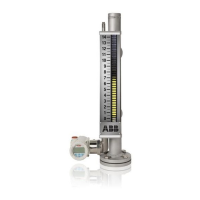7
KM26 | MAGNETIC LEVEL GAUGE | OI/KM26-EN REV I
Certifications nameplates
The MLG is identified by the name plates. The nameplate
provides information (refer to figures 2 and 3) concerning the
model number, pressure ratings, serial number, temperature
limits etc. The certification plate contains the certification-
related parameters for use in a hazardous area.
Please refer to the serial number when speaking to ABB
service department personnel.
... 2 Safety
refer to the respective datasheets of the transmitters,
switches and accessories to have the details of the IP
protection of such devices associated with the MLG system.
Grounding / earthing
The end user is responsible for grounding the KM26S or
KM26T level gauge chamber and any ancillary equipment
attached to these gauges. The end user is to provide a
grounding / earthing connection acceptable to local and
national electrical standards. Recommended locations for
pipe clamp ground or pipe strap ground are the main
chamber, the bottom or lower chamber branch connection
locations. For the KM26S, it is also acceptable to connect a
wire ring terminal to a flange stud locked in with another nut.
The grounding connection must be metal to metal so any
paint must be sanded off. Refer to figure 4 for possible
grounding locations.
Example grounding hardware is depicted below.
Figure 3 - ATEX only nameplate
Figure 4 - Ground hardware
Figure 2 - ATEX and PED nameplate
Note
The name plates shown here are only examples. The name
plates attached to the device shall contain the information
per the order.
IP protection and designation
The KM26 MLG is certified as conforming to protection type
IP68 (according to IEC 60529). The first number indicates the
type of protection the scale assembly has against the entry of
foreign bodies, including dust. ‘6’ means that it is dust-proof
(no ingress of dust). The second number indicates the type of
protection the device has against the entry of water. Please
A protective grounding connection is absolutely necessary
to ensure personnel protection, to protect against surge
(in case of installation of this option) and to prevent
explosions in potentially explosive environments.
WARNING

